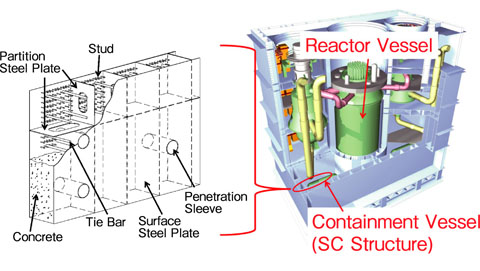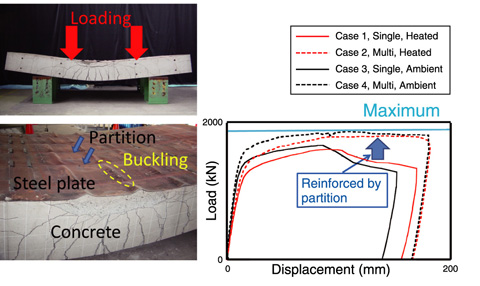
Fig.1-16 SC structure and SCCV

Fig.1-17 Results of out-of-plane bending test

Fig.1-18 Shortening of construction period when SCCV is used
The Japan Sodium Cooled Fast Reactor employs a steel plate reinforced concrete containment vessel (SCCV) (Fig.1-16). The steel plate reinforced concrete (SC) structure consists of concrete and steel plates with headed studs and is reinforced by tie bars and/or partitioning plates.
In the case of hypothetical sodium combustion, the inner plates would be exposed at high temperatures. Even under such severe conditions, the SCCV must be capable of withstanding high temperatures and high pressure and preventing leakage of radioactive nuclides. A series of tests were carried out at temperatures up to 700 °C to determine the potential characteristics of the SCCV. For example, out-of-plane bending tests were carried out to verify the influence of heat and the influence of the concrete confined between the partition steel plates on the bearing strength. Specimens were loaded to break to determine their maximum strength. Tests were carried out with a single partition specimen and a multipartition specimen with five partition plates. Fig.1-17 shows the failure mode of the multipartition specimen. Although the compression plate that acts as the boundary of the SCCV yielded and buckled, no surface crack was observed. The figure also shows the bending load-displacement relationships at a high temperature and ambient temperature. In order to directly compare the relationships for the single partition and multipartition specimens, the loads in the case of the single partition specimen were increased by a factor of five. In this figure, the concrete confined between the partition plates is observed to increase the bearing strength. The decrease in the bearing strength at high temperatures was not apparent, thanks to the concrete confinement.
From a design study point of view, the SC structure is considered to be effective in shortening the SCCV construction period when modular construction is adopted. The reactor building is divided into several modular units. The parts of a module that are made of steel are firstly assembled in a factory. The assembled steel modules are transported by a barge from the factory to the dock near the reactor building site and installed on the base mat. Therefore, the modular construction could reduce the construction period by 20% owing to the elimination of reinforcing bar installation work, which is needed for a conventional reinforced concrete (RC) structure (Fig.1-18).
Additional tests are planned for commercializing and standardizing the SCCV.